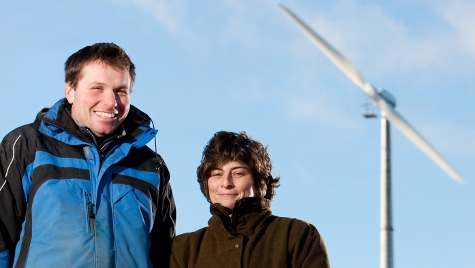
There is an old Scots saying that tells us: “If you always do whit you always did: You’ll always have whit you always hid (had).” In short; we have to be willing to change our approach if we want to be on top of any situation.
The Farm Scale Renewables sector is emerging as a major element in the development of the rural economy across the UK. At Gala- Wind we’ve been thinking hard about how to take forward the amazing growth in the use of Farm Scale (i.e. smaller than 15kW), wind turbines like our G-W133.
Government introduced the Feed in Tariff at £0.28/kWh (Index Linked) in 2010 and the market soared. The incentive was reviewed and subsequently reduced in December 2012 and has been reduced on a regular basis since. We believe that the FiT, which has been midwife to the birth of Farm Scale Renewables and vital to the growth of the sector, is set to be less relevant to the economics of the decision to make this investment. But crucially, if we go about it the right way, the investment can still provide vital support to the economics of a rural business.
There are two strands to this development, the first – thrust upon us; is a series of botched decisions by UK Governments which have degraded the FiT system where it affects Small Wind; and the other is the realisation that notwithstanding the current temporary upsets in the oil market, retail energy prices are set to be an ever larger burden on the rural economy: and the more so the further towards the fringes of the fraying Grid people are.
A Farm Scale turbine is a world away from the wind farm and similar investment projects. Similar in scale to a mature tree, it is a unit of farm machinery, in harmony with its setting and an integral part of the farm business.
In the past many people have viewed the purchase of a small wind turbine as an investment, underwritten by a guaranteed (previously generous) FiT income. As our old Scots saying above suggests: We now need to look at this proposition a little differently. If we set aside the purely investment scale: very large turbines and wind farms etc. A wind turbine produces electricity – on site!
So working to use that energy on site vastly improves the return on the investment, while future proofing against retail energy price rises and bolstering energy independence from an increasingly, under pressure National Grid – particularly at the outer fringes.
The figures speak for themselves: The FiT provides for 8.54p/kWh: export value is 4.91p /kWh usually deemed at 50% of production If we consume the energy on site, we displace a spend of around 14p/kWh. The first two figures (for new projects at least) are heading inexorably downwards: the retail price of electricity… what do you think? And by the way, you have got to earn and pay tax on that 14p before you can pay your utilities, gas or diesel providers’ bill.
The bottom line is that retail energy displacement gives you “a bigger bang for your buck”. Achieving around 50% retail energy displacement from a Gaia-Wind turbine in a position with an average annual wind speed of 5m/s is equivalent to the production of a 2m/s higher wind speed.
Wind turbines generate electricity: the feed in tariff is the icing on the cake: the electricity is the cake.
So the proposition of keeping your investment in renewables in some sort of scale with your consumption is sound. At Gaia-Wind we want to work with our turbine owners to help maximise the amount of energy we can use from our own on-site generators, the G-W133 turbine.
We want Farm scale renewables owners to share what they are doing to use energy onsite: in return we will publish as many examples as we can, to share these valuable practices as widely as possible and to help potential new entrants to more accurately calculate their investment options.
Some examples of our customers utilising their turbines to displace retail electricity are:
Stuart Stephen of Netherthirds Farm, in Aberdeenshire, Scotland:“At Netherthirds Farm we do mixed farming; cattle, sheep, and arable which includes potatoes, spring barley and mixed vegetables. My entire farm is powered by our turbine which feeds amongst other things, our house, home baking business, potato grading, grain dryer and lighting throughout the entire property.
The MgGowans, who farm in Perthshire: “We decided to lower our carbon footprint and reduce our energy costs. We installed a Gaia-Wind turbine which powers a water bore hole supplying four farms. About 73% of the energy is used on the farm and the rest is sold to the national grid. Our electricity bills have reduced by nearly a third and the extra income has helped us enormously in making farm improvements.”
